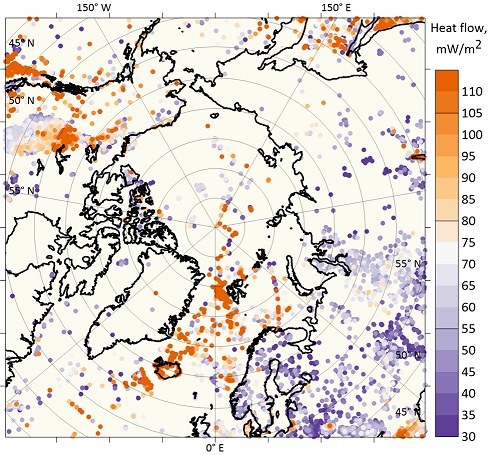|
Heat Flow
A new geothermal heat flow model based on inversion of seismic and magnetic data
This model of geothermal heat flow was obtained as a result of studying the thermal structure of the
Arctic lithosphere using a set of geophysical data. The study of geothermal heat flow is important for calculating
the long-term sustainability of engineering structures and assessing potential greenhouse gas emissions from
permafrost thawing, so these studies are especially important for high-latitude regions. Heat flow data is also
needed to estimate potential geothermal energy reserves. However, the data obtained by direct measurements are not
enough to compile a detailed map of the heat flow for most of the Arctic region.
To construct a new heat flow map for the study region, the International Heat Flow Commission
[IHFC] catalog was used as the initial approximation as heat flow data (Fig. 1).
However, this database contains large gaps. To fill these gaps, theoretical models of the global heat flow
[Davies, 2013; Lucazeau, 2019] were used, which are based on the interpolation of measured data
o take into account the structure of the lithosphere (Fig. 2, A, B).

Figure 1.
Location and values of direct heat flow measurements [IHFC 2021 database, Fuchs et al., 2021]
A method for estimating the surface heat flow using inversion of seismic and magnetic data, supported
by direct measurements is described in [Petrunin et al., 2022]. This approach allows for
using all available indirect data on the thermal structure of the lithosphere to build a thermal model
by the optimization method and minimize errors arising from uncertainty of input data.
The resulting heat flow map (Fig. 2C) agrees well with the observational data and correlates with
lithospheric domains of different tectonic history and age correspondingly. The new map reveals
some features that were not identified earlier (as seen in figures 2A, 2B, and 2C).
In particular, zones of elevated heat flow in the Bering Strait, Chukchi Sea, and a residual anomaly
in the area of the Mid-Labrador Ridge, which was active in the Paleogene. The new data also clearly
show an increase in heat flow in the ancient rift zone separating Eastern and Central Siberia,
which is not visible on maps published earlier.

Figure 2.
Comparison of heat flow maps of the Arctic based on the latest global models [Davies, 2013] (A)
and [Lucazeau, 2019] (B) with the map of the new heat flow model [Petrunin et al., 2022].
Colored dots show the location and values of direct heat flux measurements [IHFC 2021 database,
Fuchs et al., 2021].
The dataset includes the data grid obtained as a result of the study of the Arctic lithosphere thermal
structure using a complex of geophysical data.
The data are freely accessible.
The study area spans from 55° to 90°N, covering the whole Arctic, northern Eurasia and northern
North America; the initial area was larger (50° to 90°N).
The data values are in mW/m2, with an average spatial step of about 0.003°, are referenced
to geographic coordinates and also to a local system of rectangular coordinates with a center in the North geographic pole.
Data and in zip archive have the following designations:
GHF_100R_100NatN.txt - geothermal heat flow data file.
Data format description - hf_format.pdf.
The results are presented in the article:
Petrunin Aleksey G., Soloviev Anatoly, Sidorov Roman, Gvishiani Alexei
Inverse-forward method for heat flow estimation: case study for the Arctic region // Russian Journal of Earth Sciences, Volume 22, ¹ 6, 2023.
doi:10.2205/2022ES000809
References
Davies, J. H. (2013). Global map of solid Earth surface heat flow.
Geochemistry, Geophysics, and Geosystems, 14(10), 4608-4622.
Fuchs, S., Norden, B., Artemieva, I., Chiozzi, P., Dedecek, P., Demezhko, D., ... & Verdoya, M.(2021) .
The Global Heat Flow Database: Release 2021. https://doi.org/10.5880/fidgeo.2021.014.
Lucazeau, F. (2019). Analysis and mapping of an updated terrestrial heat flow data set.
Geochemistry, Geophysics, Geosystems, 20(8), 4001-4024.
Petrunin, A. G., Soloviev, A. A., Sidorov, R. V., Gvishiani, A. D. (2022).
Inverse-forward method for heat flow estimation: case study for the Arctic region.
Russian Journal of Earth Sciences, 5, doi:10.2205/2022ES000809.
|
|
|
|

